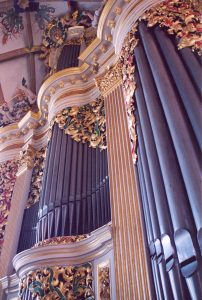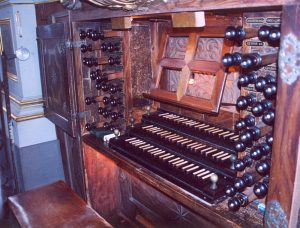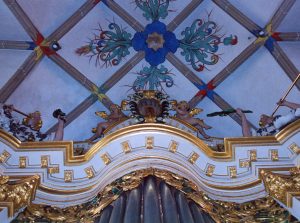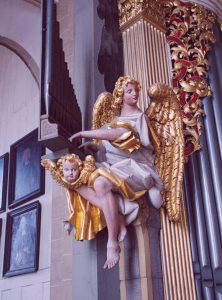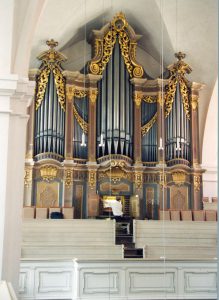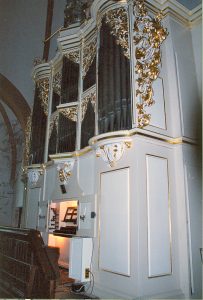Historic Organs of Germany
June 16, 2003
Freiberg
It is inevitable that in a tour of this type at least a few changes in the itinerary must be made along the way. One hopes, of course, that the need for a change of plans is discovered soon enough to avoid unnecessary effort or travel, or even soon enough to substitute a different activity or destination. We had been very fortunate on this trip not to have been delayed by funerals, weddings or construction work, so I should have been expecting a slight deviation from my plan. Monday was to be a very full, tightly scheduled “Silbermann Day,” and we were scheduled to visit five of his instruments, four in Freiberg and one in the small town of Grosshartmannsdorf. That one is of particular interest because Silbermann left registration suggestions for the instrument, and we all had planned to play works that allowed us to hear his suggestions on that organ.
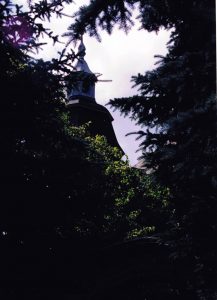 As it turned out, we never got the chance to do so.
As it turned out, we never got the chance to do so.
We arrived in Grosshartmannsdorf, found the church without any difficulty, walked up the hill and through the church yard, found the key in the door, and went inside. The door to the organ gallery, however, was locked, and no key we found on the premises—and we tried quite a few—would open it.
Nor did anyone appear who could help us attain our goal.
We saw the instrument, but after sitting and looking at it in the distance for almost an hour, we returned to the bus for the drive back to Freiberg.
The day was still a “Silbermann Day” for us, however, and the ride through another part of Saxony was pleasant. Not only that — we now have a reason to return to this beautiful part of Germany in the near future!
Freiberg: Petrikirche
So, after a lovely bus ride through Saxony, our first Silbermann organ of the day was in the Petrikirche, an active parish whose activities have required several modifications to the building, some of them resulting in an unfortunate acoustical situation, at least from the standpoint of the sound of the organ. The pitch of the instrument has also been changed, with some differences in color as a result, but the disposition is once again what it was when Silbermann finished the instrument in 1735.
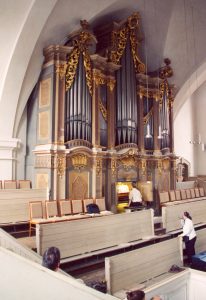 The choruses are really beautiful, even in the unfriendly room, and the sound of the 8′ Principal of the Oberwerk reminded me very much of the Positif Montre on the instrument I teach on regularly. The flutes are replacements for the original stops, and their color is perhaps a little duller than I expected. One stop that interested me particularly was the Viol di gamba on the Hauptwerk. This was the first Silbermann string we had heard, and I was surprised to hear that this conical stop was voiced less like a string than a Spitzflöte. In fact, it sounded like the 4′ Spitzflöte on the same chest.
The choruses are really beautiful, even in the unfriendly room, and the sound of the 8′ Principal of the Oberwerk reminded me very much of the Positif Montre on the instrument I teach on regularly. The flutes are replacements for the original stops, and their color is perhaps a little duller than I expected. One stop that interested me particularly was the Viol di gamba on the Hauptwerk. This was the first Silbermann string we had heard, and I was surprised to hear that this conical stop was voiced less like a string than a Spitzflöte. In fact, it sounded like the 4′ Spitzflöte on the same chest.
Another stop that interested me was the Vox humana on the Oberwerk, and it too surprised me with its color. I was reminded once again of a Clarinet, just as I had been hearing the Trompete in Steinkirchen. The only Vox humana I have heard that compares to this one is on the Thomaskirche organ in Strasbourg, where I remember noticing the great similarity between the color of the Vox and the color of the Cromorne. Of course, Gottfried Silbermann’s nephew Johann Andreas built that organ, so I shouldn’t have been surprised. But I was.
 The demonstration by Andreas Hain was excellent, and we all enjoyed hearing him play. We enjoyed our chance to play even more, of course, and felt we were beginning to adjust to the keydesk dimensions—particularly the pedalboards—as we played. The only surprise some of us found was the compass of the pedalboard, which was too short to play some of our favorite pieces.
The demonstration by Andreas Hain was excellent, and we all enjoyed hearing him play. We enjoyed our chance to play even more, of course, and felt we were beginning to adjust to the keydesk dimensions—particularly the pedalboards—as we played. The only surprise some of us found was the compass of the pedalboard, which was too short to play some of our favorite pieces.
After enjoying the “open console” for a time, we had to leave and go to our next appointment — the Freiberg Cathedral and Gottfried Silbermann’s Opus 2.
Freiberg: Cathedral
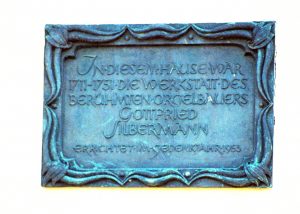 We walked from the Petrikirche to the Cathedral, and along the way passed a Bank that had a sign on the front proclaiming their location to be that of the Silbermann Organ Works from 1711 until his death. His location in Freiberg for virtually all of his productive years actually made a difference in our itinerary, because most of his extant instruments are located within only a short drive (by today’s standards) from this city.
We walked from the Petrikirche to the Cathedral, and along the way passed a Bank that had a sign on the front proclaiming their location to be that of the Silbermann Organ Works from 1711 until his death. His location in Freiberg for virtually all of his productive years actually made a difference in our itinerary, because most of his extant instruments are located within only a short drive (by today’s standards) from this city.
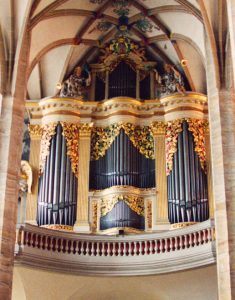 The organ of the Cathedral in Freiberg is not only particularly beautiful, it is significant in the development of the distinctive style of Silbermann’s cases. As Cathedral organist Dietrich Wagler explained, the case of Opus 2 was built to a design drawn by Elias Lindner, organist of the Cathedral at the time the contract was signed with Silbermann. The presence of an Oberwerk instead of a Rückpositiv, the gently rounded, wide towers, and the absence of Pedal towers in the design can be seen in all Silbermann’s later instruments.
The organ of the Cathedral in Freiberg is not only particularly beautiful, it is significant in the development of the distinctive style of Silbermann’s cases. As Cathedral organist Dietrich Wagler explained, the case of Opus 2 was built to a design drawn by Elias Lindner, organist of the Cathedral at the time the contract was signed with Silbermann. The presence of an Oberwerk instead of a Rückpositiv, the gently rounded, wide towers, and the absence of Pedal towers in the design can be seen in all Silbermann’s later instruments.
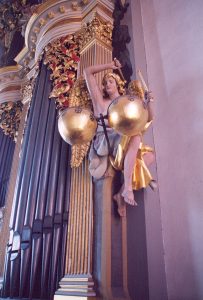 The decorative figures on the sides, however, are unique to this instrument. We often see photographs of one of these figures, with the angel playing the portative organ that seems to be magically suspended at the right height. There’s even a wind trunk to the instrument, even though the pipes cannot be played from the keydesk. In fact we see all sorts of photographs of this instrument, even on the covers of reprint editions of music of every sort. We are less likely to see photographs of the other angel, who appears to be playing the drums with a great deal of energy, but you can get a look if you pass your mouse pointer over the photograph to the right.
The decorative figures on the sides, however, are unique to this instrument. We often see photographs of one of these figures, with the angel playing the portative organ that seems to be magically suspended at the right height. There’s even a wind trunk to the instrument, even though the pipes cannot be played from the keydesk. In fact we see all sorts of photographs of this instrument, even on the covers of reprint editions of music of every sort. We are less likely to see photographs of the other angel, who appears to be playing the drums with a great deal of energy, but you can get a look if you pass your mouse pointer over the photograph to the right.
 Herr Wagler’s demonstration began on the small organ, moved to the Cathedral in 1939 from the Johanniskirche in Freiberg. This one-manual instrument has in this large space a wonderful sound, very clean, bright and “silvery.” The major part of the demonstration, however, was given on the large organ, and we heard its Grand jeux, Pleins jeux, Jeu de tierce, and Cornets in addition to its more “Teutonic” choruses as Herr Wagler played appropriate literature
Herr Wagler’s demonstration began on the small organ, moved to the Cathedral in 1939 from the Johanniskirche in Freiberg. This one-manual instrument has in this large space a wonderful sound, very clean, bright and “silvery.” The major part of the demonstration, however, was given on the large organ, and we heard its Grand jeux, Pleins jeux, Jeu de tierce, and Cornets in addition to its more “Teutonic” choruses as Herr Wagler played appropriate literature
and improvised for us.
Although we had been told not to expect to be able to play the instrument, Herr Wagler invited us to the gallery where we spent quite some time playing this historic organ.
As we had noticed in the Petrikirche, the Viol di gamba is a conical stop voiced more as a flute than a string, the Principal on the Oberwerk is noticeably smaller than the same stop on the Hauptwerk, and the reeds are fundamental and in the case of the trumpet and pedal reeds, big and strong. The 32′ Untersatz was amazing, with double stopped pipes on each note of the bottom octave. In this space, with its hard surfaces and resulting resonance, the sound was unlike any stopped 32′ I’ve ever heard.
Freiberg: Jacobikirche
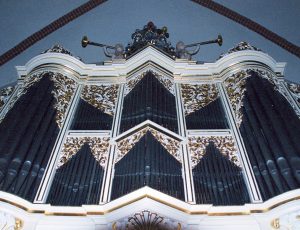 Our final Silbermann organ of the day was the small instrument in the Jacobikirche, located outside the walls of the old city. Cantor Apmann ushered into the church, where we were responsible for our own demonstration of the instrument. We stayed long enought for everyone to have a final chance to play one of these wonderful instruments.
Our final Silbermann organ of the day was the small instrument in the Jacobikirche, located outside the walls of the old city. Cantor Apmann ushered into the church, where we were responsible for our own demonstration of the instrument. We stayed long enought for everyone to have a final chance to play one of these wonderful instruments.
Finally, after a very long day in Freiberg, we boarded the bus and made the early evening drive to Leipzig, where even more wonders awaited us.

